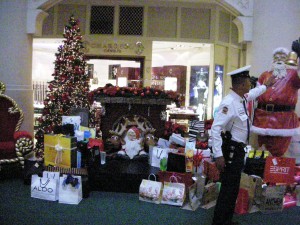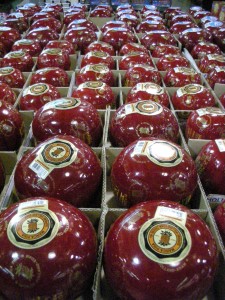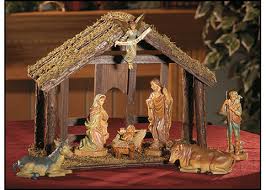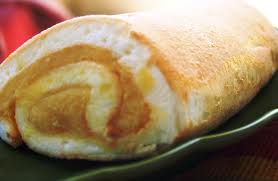 …And then, that hidden tendency in all of us to behave like peevish expat princesses over small molehills that are part of expat life anywhere is swept away by the joy and childlike enthusiasm of the Christmas season. News of Christmas bazaars of all shapes and sizes come fluttering through my inbox like confetti. Rockwell is aglow with orange fairy lights, while Bel-Air is bedecked in parols (traditional Filipino star shaped lanterns in red and yellow and white) hanging from every tree. Many homes are strung with a vast array of lights and decorations, and I have never seen so many Christmas trees in my life: in malls, in parks, in every store and restaurant and office and lobby. Not to mention the snow and reindeers and Siberian tigers, Christmas elves, Giant Santas, and, and, and…
…And then, that hidden tendency in all of us to behave like peevish expat princesses over small molehills that are part of expat life anywhere is swept away by the joy and childlike enthusiasm of the Christmas season. News of Christmas bazaars of all shapes and sizes come fluttering through my inbox like confetti. Rockwell is aglow with orange fairy lights, while Bel-Air is bedecked in parols (traditional Filipino star shaped lanterns in red and yellow and white) hanging from every tree. Many homes are strung with a vast array of lights and decorations, and I have never seen so many Christmas trees in my life: in malls, in parks, in every store and restaurant and office and lobby. Not to mention the snow and reindeers and Siberian tigers, Christmas elves, Giant Santas, and, and, and…
In the Philippines, Christmas, or Pasko is the long-awaited time of the year when families get together, extra special when family members come home from working overseas. The  Christmas season kicks in with the “Ber” months (SeptemBER, OctoBER, NovemBER..?), so by now, if you are not in the mood, you must be both blind and deaf to the decorations and muzak filling every shopping mall and department store. But don’t panic if you haven’t caught up yet, because the season continues well into January.
Christmas season kicks in with the “Ber” months (SeptemBER, OctoBER, NovemBER..?), so by now, if you are not in the mood, you must be both blind and deaf to the decorations and muzak filling every shopping mall and department store. But don’t panic if you haven’t caught up yet, because the season continues well into January.
Filipinos are predominantly Roman Catholic, and the Philippines is the largest bastion of Christianity in Asia, so it is hardly surprising that Christmas is a Really Big Deal here. It is a time for family, fiestas and food, gifts and, of course, religion.
Religious observances at Christmas begin with December 16 and the Novena, or nine dawn masses known as the Misa de Gallo (Rooster’s Mass in Spanish) or Simbang Gabi (literally, Night Mass in Tagalog). After the service, communicants will snack on puto bumbóng (a purple, sticky rice cake steamed in bamboo tubes, buttered and sprinkled with brown sugar and shredded coconut ) and bibingka (rice flour and egg-based cake) while sipping on coffee, salabát (ginger tea) or tsokoláte (a thick, Spanish-style, hot chocolate) that are sold at stalls outside the church.
 Christmas in the Philippines is a real halo halo of Filipino and western traditions, but the one we all recognize is the need to be with family. As December 24th dawns, the last Novena mass is attended; then preparation begins for Noche Buena, when families feast together after Midnight Mass on queso de bola (Edam cheese sealed with red wax) tsokoláte, pasta, fruit salad, pan de sol (Filipino bread rolls), relleno, lechon or hamón (Christmas ham). Christmas Eve is a night without sleep and a continuous celebration right through to Christmas Day.
Christmas in the Philippines is a real halo halo of Filipino and western traditions, but the one we all recognize is the need to be with family. As December 24th dawns, the last Novena mass is attended; then preparation begins for Noche Buena, when families feast together after Midnight Mass on queso de bola (Edam cheese sealed with red wax) tsokoláte, pasta, fruit salad, pan de sol (Filipino bread rolls), relleno, lechon or hamón (Christmas ham). Christmas Eve is a night without sleep and a continuous celebration right through to Christmas Day.
The Misa de Aguinaldo is a service celebrated on December 25, and is usually attended by the whole family. The centre of any family gathering is lola, or grandmother, the family matriarch, and Christmas day is also a time for children to pay their respects to their grandparents and godparents. This is known as Pagmamáno and it is performed by lifting the elder’s hand to one’s forehead, while saying the phrase ‘Mano Po’ (‘your hand, sir’). The elder then blesses you, and in return gives Aguinaldo, or crisp new bank notes. It is a day of family togetherness, and everyone wishes ‘Maligayang Pasko’ (Merry Christmas).
 Christmas ends with Epiphany. More commonly known as Three Kings’ Day in the Philippines (Tres Reyes in Spanish or Tatlóng Harì in Tagalog), it was traditionally commemorated on January 6 but is now celebrated on the first Sunday after the New Year. Children leave their empty shoes out in expectation of small gifts.
Christmas ends with Epiphany. More commonly known as Three Kings’ Day in the Philippines (Tres Reyes in Spanish or Tatlóng Harì in Tagalog), it was traditionally commemorated on January 6 but is now celebrated on the first Sunday after the New Year. Children leave their empty shoes out in expectation of small gifts.
In some regions, the season may even be extended until the Feast of the Santo Niño de Cebú on the third Sunday of January. The Santo Niño de Cebú, or Holy Child of Cebu, is a Filipino statue of the Child Jesus reminiscent of the Infant Jesus of Prague. The statue was originally brought to the Philippines by Ferdinand Magellan and given to Rajah Humabon and his wife Humamay in 1521. Measuring only twelve inches tall, it is claimed to be the oldest holy statue in the country. The Santa Niño gained prominence when it miraculously survived a parish fire in 1565. It is now housed under bulletproof glass at the Basilica Minore del Santo Niño in Cebu City, clothed in lavish robes and a gold crown, donated by devotees from both the Philippines and abroad.
 A Belen, or Nativity scene, is usually found in houses, churches and even business establishments. It shows the infant Jesus laid in a manger being watched over by Mary and Joseph. Some also include the Magi with their gifts, shepherds, animals and angels. The manger should be empty until Christmas Day, when an image of the baby Jesus is placed in it to signify His birth.
A Belen, or Nativity scene, is usually found in houses, churches and even business establishments. It shows the infant Jesus laid in a manger being watched over by Mary and Joseph. Some also include the Magi with their gifts, shepherds, animals and angels. The manger should be empty until Christmas Day, when an image of the baby Jesus is placed in it to signify His birth.
Christianity came to the Philippines with the Spanish in the sixteenth century, and with them, too, came a plethora of new dishes previously unknown to this Pacific archipelago. These ‘foods of the conqueror’ often assumed a dignity they did not possess in Spain, as they had to be made with ingredients imported from half way round the world (either Spain or Mexico). This also meant they were often too expensive for the Filipinos to eat on a daily basis. Gradually, however, they crept into Filipino kitchens to be adapted into ‘fiesta fare’: food made only for Christmas and other special occasions. Spanish stews would become ‘a reckless combination of pork, chicken, beef, vegetables, chorizo, jamon China [and] morcilla’). Paella would be filled with ‘a luxurious mix of the local and foreign’, while rellenos became ‘anything that can conceivably be stuffed’. Rich elaborate desserts such as tortas imperiales (almond cake) and Brazo de Mercedes (a meringue roll filled with butter cream or custard) created ‘a repertoire of sweetness’ in Philippine cuisine.
would become ‘a reckless combination of pork, chicken, beef, vegetables, chorizo, jamon China [and] morcilla’). Paella would be filled with ‘a luxurious mix of the local and foreign’, while rellenos became ‘anything that can conceivably be stuffed’. Rich elaborate desserts such as tortas imperiales (almond cake) and Brazo de Mercedes (a meringue roll filled with butter cream or custard) created ‘a repertoire of sweetness’ in Philippine cuisine.
Filipinos are notorious for their unadulterated joy in food. This is worth bearing that in mind when considering Christmas presents for Filipino staff, teachers, and neighbours. Moving to a new country often brings with it the unexpected confusion of cultures clashing. So many strange questions can go through your head at each new encounter. What do you do when a casual acquaintance invites you to join him/her for lunch? Should you feel offended when guests turn up late for dinner? Should you take off your shoes when entering someone’s home? And not least is the issue of giving presents to staff at Christmas.
 As expatriates in the Philippines, most of us are blessed with the luxury of household staff, from a driver and part time maid to full time housekeepers and cooks, yayas (nannies), gardeners and security guards. Some of you are probably already acquainted with the Christmas bonus, when an extra month’s pay is handed out, preferably early in December, and certainly no later than December 24th. For those living in a gated community, it can seem as if your purse is permanently open, not only personal staff, but rubbish collectors, laundry women, and postmen will expect a little extra at Christmas. If you aren’t so keen to pay cash in recognition of good service, again, food is always appreciated, and most supermarkets are full of pre-packed gift baskets filled with Spam and queso de bola and tins of fruit cocktail.
As expatriates in the Philippines, most of us are blessed with the luxury of household staff, from a driver and part time maid to full time housekeepers and cooks, yayas (nannies), gardeners and security guards. Some of you are probably already acquainted with the Christmas bonus, when an extra month’s pay is handed out, preferably early in December, and certainly no later than December 24th. For those living in a gated community, it can seem as if your purse is permanently open, not only personal staff, but rubbish collectors, laundry women, and postmen will expect a little extra at Christmas. If you aren’t so keen to pay cash in recognition of good service, again, food is always appreciated, and most supermarkets are full of pre-packed gift baskets filled with Spam and queso de bola and tins of fruit cocktail.
It is important that presents are beautifully wrapped, to show that a lot of thought and time went into each gift, and the more festive and beribboned the wrapping, the better.  But don’t panic if you, like me, are liable to tie yourself in knots with ribbon and tape, as most malls and department stores have wrapping services at reasonable prices that add a lot glamour to even the smallest parcel. But don’t be disappointed if they don’t open your present in front of you. This is considered the height of bad manners in the Philippines, as it may cause embarrassment to both the giver and the receiver.
But don’t panic if you, like me, are liable to tie yourself in knots with ribbon and tape, as most malls and department stores have wrapping services at reasonable prices that add a lot glamour to even the smallest parcel. But don’t be disappointed if they don’t open your present in front of you. This is considered the height of bad manners in the Philippines, as it may cause embarrassment to both the giver and the receiver.
Filipinos love a party, and of course Christmas provides the perfect excuse for celebration and pageantry. Office parties abound in the weeks leading up to the holiday: colourful and elaborate, everyone is welcome. Kris Kringle, or Monita Monita, is a major part of the celebration, but fun and laughter is just as important.
So throw away those daily frustrations and get into the spirit of Christmas! There isn’t a better place to do it than Manila!
